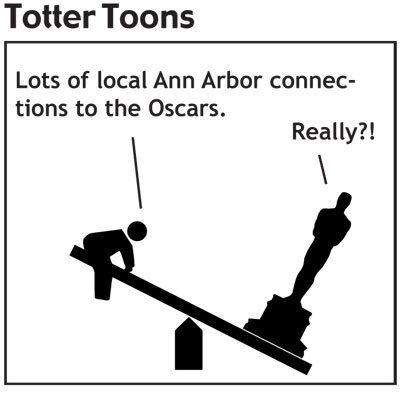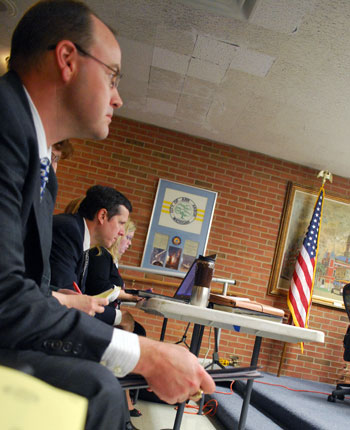“Argo Cascades” at the dam. [photo]
Stories indexed with the term ‘Argo Dam’
Argo Dam
I took this two years ago and Walter was there again today. Same red shirt. He says the fishing is better now, especially with the high water today. [photo]
Argo Dam
I am now sitting at my desk watching two bald eagles fly upstream, just passing over Argo Dam. First time for two at once and flying so low. Also seeing great blue herons just below the dam for the first time in 10 years in the wintertime, even below zero.
Argo Dam
Argo Dam. [360-degree panorama]
Argo Dam
New portage. By Argo Dam taken from below: [photo]
Deliberations on DDA Pave Way for Final Vote
Ann Arbor city council meeting (April 1, 2013): The council’s first meeting in April featured some progress on items that have appeared repeatedly on its agenda in the last several weeks.
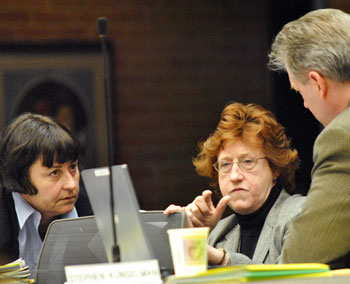
From left: Jane Lumm (Ward 2), assistant city attorney Mary Fales and Stephen Kunselman (Ward 3). (Photos by the writer.)
After two postponements, the council gave initial approval to a set of changes to the ordinance that establishes the Ann Arbor Downtown Development Authority (DDA). The changes can be divided into those that affect board composition and those that relate to the computation of the DDA’s tax increment finance (TIF) capture.
The tax calculations have implications of roughly $1 million a year for the DDA and the taxing jurisdictions whose taxes are captured by the DDA. Those taxing jurisdictions include the city of Ann Arbor, Washtenaw County, Washtenaw Community College and the Ann Arbor District Library. The vote was 7-3, as mayor John Hieftje, Margie Teall (Ward 4) and Chuck Warpehoski (Ward 5) voted no. Christopher Taylor (Ward 3) was absent. The final vote will likely come at the council’s April 15 meeting. Councilmembers are not obligated to vote the same way the second time around.
The council also wrapped up an issue that has appeared on its agenda for several meetings. At its March 18 meeting, the council had finally decided not to enact a moratorium on site plan applications in D1 (downtown core) zoning districts. Instead, the council had directed the planning commission to conduct a review of D1 zoning. But councilmembers had left open the question of the exact scope of work and the timeframe for its completion by planning commissioners. At the April 1 meeting, the council allowed the commission six months, until Oct. 1, to review the following: the appropriateness of D1 zoning on the north side of Huron Street between Division and South State and the south side of William Street between South Main and Fourth Avenue; the residential premiums; the zoning for the University of Michigan Credit Union parking lot.
Other business was further delayed by the council. At the developer’s request, the council postponed for a second time the 413 E. Huron project, a proposed 14-story, 216-apartment building at the northeast corner of Huron and Division streets. That project will come back before the council at its April 15 meeting. A new public hearing on the 413 E. Huron site plan application was started on April 1 and will continue on April 15.
The council also postponed a second and final vote on changes to the city’s sign ordinance. The changes would prohibit any new billboards, and allow only a limited range of digital signs. That won’t come back before the council until May 6. Several people addressed the council during the public hearing. All of them worked for Adams Outdoor Advertising, and spoke in opposition to the changes. Because of the postponement, the council extended a moratorium on digital sign applications, which has now been in place for a year.
The council also extended a moratorium on spending of monies that have been set aside under the city’s Percent for Art ordinance. A revision to that ordinance, which would likely eliminate the public art set-aside but still allow for aesthetic elements to be built into a project, is expected to be brought forward in the next few weeks. The public art ordinance revisions are being crafted by a council committee that was tasked with that responsibility in December of 2012.
At its April 1 meeting, the council also approved contracts for renovations at the Gallup Park canoe livery, and the Argo and Geddes dams. In addition, the council approved a lease for additional parking in connection with the Argo Cascades.
Other business at the meeting included council approval of the notice to issue bonds for the city’s drinking water system. The council also authorized contracts in connection with street reconstruction and sidewalk repair work for the 2013 season. [Full Story]
Parks Agenda: Downtown, Dogs, Dams, DTE
Ann Arbor park advisory commission meeting (March 19, 2013): A packed agenda for this month’s PAC meeting included several items related to downtown parks and the Huron River.
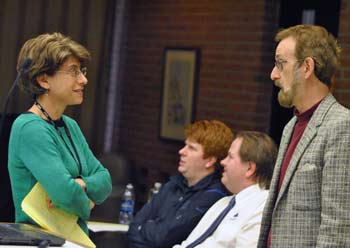
Park planner Amy Kuras, left, talks with Stewart Gordon, an advocate for putting an ice-skating rink atop the Library Lane site. In the background are Andrew Walton, left, and Doug Kelly, the city’s director of golf. Walton supervises the Huron Hills golf course. (Photos by the writer.)
Commissioners discussed a proposal to build an ice-skating rink atop a portion of the city-owned Library Lane underground parking structure. They took no action on the item, but were briefed on the proposal by two advocates of the effort: Alan Haber and Stewart Gordon. The two men also attended a subsequent March 26 meeting of a PAC downtown park subcommittee. This report includes a summary of that session as well.
River-related items on PAC’s March 19 agenda included a resolution to recommend awarding a $295,530 contract to Gerace Construction Co. for repair work and repainting at Argo and Geddes dams, as well as site improvements around Argo Dam. Brian Steglitz, an engineer with the city, told commissioners that the work is being done in response to the most recent inspection by state regulators.
Commissioners also recommended awarding a $512,180 contract for improvements at the Gallup Park canoe livery to Construction Solutions Inc., which will be funded in part by a $300,000 state grant. Cheryl Saam, facility supervisor for the Argo and Gallup canoe liveries, gave commissioners a presentation on those operations, in preparation for budget recommendations that PAC is expected to consider at its April 16 meeting.
As part of her report, Saam noted that the city plans to issue another request for proposals (RFP) to design a whitewater section along the Huron River, downstream from the Argo Dam near the Argo Cascades. Parks and recreation manager Colin Smith reminded commissioners that the first attempt at this project wasn’t successful. The Michigan Dept. of Environmental Quality did not approve the initial design, and would not issue the necessary permit for the project. The staff is working with the state to address MDEQ’s concerns, he said. Smith also reported that DTE Energy still intends to pay for the project, which is located adjacent to property that the utility company is cleaning up.
DTE representatives were on hand at the meeting because of a different project: To request an easement on city-owned land in Riverside Park, where utility poles are located. The easement is needed as part of an $8 million new electrical substation that DTE is building on land adjacent to the park. Commissioners unanimously recommended that the city council approve the easement.
In another presentation to set the stage for next month’s budget discussion, PAC heard from Doug Kelly, the city’s director of golf, and Andrew Walton, recreational facility supervisor at Huron Hills. They reviewed the status of the city’s two golf courses – at Huron Hills and Leslie Park – and noted that both courses have seen significant revenue gains over the past five years.
The issue that drew the most public commentary during the meeting wasn’t on the March 19 agenda: a possible dog park on a knoll in West Park. Residents in that area aren’t happy about the prospect of barking dogs in their neighborhood. [Full Story]
Money OK’d for Dam Work at Argo, Geddes
The Ann Arbor city council has authorized the award of a $295,530 contract to Gerace Construction Co. for repair work and repainting at Argo and Geddes dams, as well as site improvements around Argo Dam. The council took the action at its April 1, 2013 meeting.
The contract had been recommended for approval by the city’s park advisory commission (PAC) at its March 19, 2013 meeting.
Gerace, based in Midland, submitted the lowest of four qualified bids for this work. Other bidders were Anlaan Corp. ($354,050); E&L Construction ($457,989); and Spence Brothers ($797,000). According to a staff memo, the work entails “repair and repainting of gear housings, lift equipment, tainter gate structural steel, miscellaneous concrete repair, and minor site improvements. Site … [Full Story]
Contract OK’d for Work at Argo, Geddes Dams
The Ann Arbor park advisory commission has recommended awarding a $295,530 contract to Gerace Construction Co. for repair work and repainting at Argo and Geddes dams, as well as site improvements around Argo Dam. The action took place at PAC’s March 19, 2013 meeting on a unanimous vote.
Gerace, based in Midland, submitted the lowest of four qualified bids for this work. Other bidders were Anlaan Corp. ($354,050); E&L Construction ($457,989); and Spence Brothers ($797,000). According to a staff memo, the work entails “repair and repainting of gear housings, lift equipment, tainter gate structural steel, miscellaneous concrete repair, and minor site improvements. Site improvements include addition of riprap and constructing a path to portage around Argo Dam.”
Brian Steglitz, an engineer … [Full Story]
EPA, Others Object to Whitewater Project
Four entities – including the federal Environmental Protection Agency and the local Huron River Watershed Council – have filed letters of objection with the state of Michigan to a project that would add a recreational section of whitewater along the Huron River, next to the new Argo Cascades.
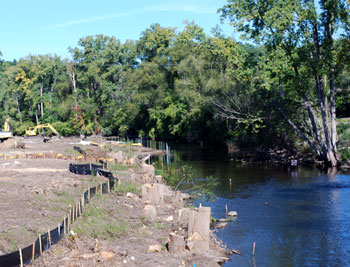
A view looking upstream at the Huron River from the Broadway Bridge, toward the section of the proposed whitewater feature. On the left is environmental remediation work on the DTE/MichCon property. (Photo by D. Askins.)
Colin Smith, Ann Arbor’s parks and recreation manager, informed the park advisory commissioners about the opposition at PAC’s Sept. 18, 2012 meeting, describing the news as “not especially positive.” Other letters filed against the project were from the state Dept. of Natural Resources fisheries division and the U.S. Fish & Wildlife Service.
The project requires a permit from the Michigan Dept. of Environmental Quality (MDEQ) because it affects the Huron River, a state waterway. The project was originally approved by the Ann Arbor city council in 2010, as part of a larger effort that included building the Argo Dam bypass, which wrapped up earlier this year. Subsequent to that council approval, DTE Energy offered to pay for and oversee the whitewater aspect, to coordinate it with environmental remediation work that’s taking place on property it owns along that stretch of the river, just downstream of Argo Dam.
DTE is the applicant for the whitewater permit, although the company is working closely with the city on the project. The city is interested in acquiring the DTE property along the Huron after remediation is completed – and it’s hoped that the company might gift it to the city as a park.
Smith told PAC members that the EPA objection – because it comes from a federal environmental oversight agency – has triggered a process that might stop the project. The EPA filed its letter on Aug. 15. From that date, the MDEQ has 90 days [until Nov. 13] to resolve the EPA’s concerns with the applicant.
The EPA’s letter from Tinka Hyde, director of the agency’s water division, states that the project could significantly degrade the Huron River by inhibiting fish passage and increasing the water velocity, which in turn could affect sediment flow and degrade the stability of that section of the river. Another concern cited is that the project could constrain public use of the river. Because of these issues, the EPA believes the project does not comply with the federal Clean Water Act. [.pdf of EPA letter]
Similar concerns were cited in the other letters of objection. Additional issues raised include water quality concerns that could affect the health of those using the whitewater area, who might come in contact with E.coli in the river; and exacerbated flow problems during drought periods. [U.S. Fish & Wildlife Services letter] [DNR fisheries division letter and additional attachments] [HRWC letter]
The DNR fisheries letter – signed by Jeffery Braunscheidel, senior fisheries biologist – also alludes to the contentious “dam in/dam out” debate involving Argo Dam. Structures used to create the whitewater are in essence dams, he stated, and the division does not support new dam construction. “Planning should provide for a naturally functioning system below Argo Dam as history has made clear that, at some point in time, the Argo Dam will be modified or removed. Impediments should not be constructed in the river that the public will again be asked to address.”
But it’s the EPA’s objection that carries the most weight. If the EPA does not withdraw its objection and the MDEQ still decides to grant the permit, then DTE would also need to seek a permit from the U.S. Army Corps of Engineers before the project can move forward. [Full Story]
Totter Toons: Ann Arbor Goes to the Oscars
More Concerns Aired on Fuller Road Station
Ann Arbor park advisory commission meeting (Nov. 15, 2011): With no action items on the agenda, PAC’s November meeting was filled with updates and honors, farewells and a few pointed comments regarding Fuller Road Station.

At left: Lynn Bowen, an administrative assistant with the city who provides staff support for the park advisory commission, is retiring and was honored at PAC's November meeting. She has worked at the city for 26 years, including the last six years with parks and recreation. To the right are PAC chair Julie Grand and Colin Smith, the city's parks and recreation manager. (Photos by the writer.)
Commissioners were briefed by city staff about annual finances related to the land acquisition for parks and greenbelt programs, which are funded by a 30-year millage. They also got an update on the city’s marketing efforts for parks and recreation, and heard a report on the status of a sustainability project – several PAC commissioners had attended a September joint work session to help prioritize city goals related to environmental quality, economic vitality, and social equity.
Updates were also given about a sediment removal project in the Ruthven Nature Area, and about two parking-related projects at Riverside Park and Veterans Memorial Park.
In his manager’s report, Colin Smith noted that he’d taken a canoe run through the under-construction Argo Dam bypass pools – the new channel was a ”bit sportier” than he had expected, and is still being tweaked. He also told commissioners he’d received word that two state grant applications made by the city of Ann Arbor – $300,000 for the proposed Ann Arbor skatepark at Veterans Memorial Park, and $300,000 for improvements at the Gallup Park canoe livery – had ranked in the top 12 out of 100 applications statewide for funding from the Michigan Natural Resources Trust Fund. That bodes well for the possibility that the grants will be awarded – a decision from the state is expected in December.
During the meeting commissioners also honored two volunteers with the city’s natural area preservation program – Sarah Newman and Drew Lathin – and said farewell to Lynn Bowen, the administrative assistant who works with PAC. The meeting was her last before retiring from the city.
An item not on the agenda – the proposed Fuller Road Station – drew focus from public commentary as well as some questions from commissioners later in the meeting. [Full Story]
Action on Argo Headrace, Trails Near Fuller
Ann Arbor park advisory commission meeting (Aug. 16, 2011): During a three-hour meeting on Tuesday, park commissioners walked down several topical trails in what PAC chair Julie Grand aptly described as a “super-packed” agenda.

The view looking east down the dewatered Argo headrace, with the embankment on the right. The trail along the embankment to Broadway is closed, as the city prepares for major reconstruction of the headrace. (Photos by the writer.)
Commissioners approved a resolution recommending a change to the scope of work at the Argo headrace – a change that will add a new entrance to the soon-to-be-reconstructed waterway from Argo Pond to the Huron River. The modification to the project was linked to an offer from DTE to pay for a whitewater section that’s part of the overall project, which freed up city funds for the new entrance. A state permit needed to start the reconstruction is expected to be received by Aug. 23.
A second resolution introduced at Tuesday’s meeting urged the city council to incorporate design of a trail system – including the county’s Border to Border (B2B) trail – into the Fuller Road area in advance of building the proposed Fuller Road Station. Two members of the Washtenaw Bicycling & Walking Coalition were on hand with suggestions for where trails might be located to bypass the busy intersection of Fuller Road, Maiden Lane and East Medical Center Drive.
The topic of trails also emerged tangentially during a presentation by PAC vice chair John Lawter on dog parks. Some people walk their dogs off leash on park trails and in other park areas, violating Ann Arbor’s ordinance requiring dogs to be leashed. The exception is in the city’s two dog parks, on the north and south edges of town.
Lawter suggested that Ann Arbor might find other ways to let dogs off leash, either by creating another traditional dog park that’s more centrally located, or designating certain hours for dogs to be off leash in specific parks. PAC might form a subcommittee to explore options for a new dog park, and for how to increase enforcement of existing dog-control ordinances. Such an effort might uncover more data points like those Lawter provided in his presentation, which included the pounds of poo collected annually at Swift Run dog park.
Data collection has also been part of developing the city’s first urban forest management plan. Oliver Kiley of JJR, the consultant leading this project, updated the commission on the effort. Possible outcomes include a recommended maintenance plan, protections for mature trees, targets for new tree plantings, and proposals for relevant ordinances and zoning. The discussion among commissioners led to concerns over whether the city is prepared for something similar to the emerald ash borer – which decimated thousands of trees in the city over the past decade and chewed up the city’s forestry budget for several years.
The urban forest management plan will be among the 26 city plans in a sustainability framework being developed, focused on “triple-bottom line” goals of economic vitality, environmental quality and social equity. The commission was briefed on this project in preparation for a Sept. 27 joint meeting of the park, planning, energy and environmental commissions. The goal of that meeting is to start prioritizing goals from these existing city plans. [Full Story]
PAC Recommends Change to Argo Project
At its Aug. 16, 2011 meeting, the Ann Arbor park advisory commission recommended amending the project scope with TSP Environmental for work on the Argo dam headrace. [.pdf of staff memo and resolution]
The Livonia firm had been hired last year to build a bypass channel in the headrace for $988,170 and to add whitewater features for an additional $180,000. However, DTE is now offering to pay for the whitewater feature of the Argo dam project, if the city agrees to hold off on construction of that piece until after DTE completes remediation on its nearby property, as required by the state.
By having DTE pay for the work, the city is expected to save $163,636. The resolution approved at Tuesday’s PAC … [Full Story]
RiverUp! Focuses on Revitalizing Huron River
Ann Arbor park advisory commission (July 19, 2011): A new project to shore up the ecological health and recreational infrastructure of the Huron River – and to strengthen the economies of river communities like Ann Arbor and Ypsilanti – is getting ready for its public debut in mid-August. Park commissioners were briefed on the RiverUp! effort at their July meeting, and were invited to an Aug. 16 bus tour of sites that will be given initial attention in the Ann Arbor and Ypsilanti area.
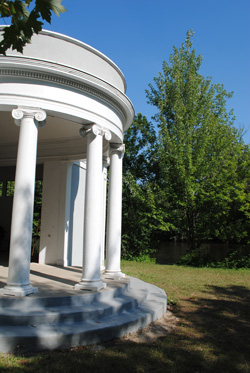
Greek Revival shelter at Island Park, where an event to launch the RiverUp! project will be held on Aug. 16. (Photos by the writer)
Elizabeth Riggs of the Huron River Watershed Council, which is coordinating the project, told PAC members that RiverUp! is spearheaded by a conservancy group called the Wolfpack. Co-founded by attorney and former Clinton advisor Paul Dimond and retired Ford executive Ray Pittman, Wolfpack members – mostly from the Ann Arbor area – have been previously focused on state issues. Now, Riggs said, they are turning their attention to a 104-mile stretch of the Huron River, starting from the north at Milford through Ann Arbor and Ypsilanti, and downstream to Flat Rock.
Also at their July meeting, commissioners got an update about efforts to build an Ann Arbor skatepark. They also reviewed tentative FY 2011 budget results for the parks system – finals numbers will be presented to the commission in August.
Several other topics were discussed or mentioned during the meeting, in the form of communications from staff or commissioners: (1) an update on work at Argo dam; (2) concerns over the proposed Fuller Road Station and the site design’s consideration of the Border-to-Border Trail; (3) a roughly $100,000 donation from the Henrietta Feldman trust; (4) news of the resignation of Greta Brunschwyler, executive director of the Leslie Science & Nature Center; and (5) a preview of an August agenda item regarding dog parks.
Other news regarding the Argo dam project – a $1.17 million effort to build a bypass channel in the Argo dam headrace, and to add whitewater features – emerged the week after PAC’s July 19 meeting.
A July 25 memo from city staff reports that the city was recently notified by DTE officials of upcoming remediation work that DTE plans to do in 2012 adjacent to DTE’s property on the south side of the Huron River, between Allen Creek Drain and the Broadway Bridge. The remediation is being required by the Michigan Dept. of Environmental Quality.
DTE is offering to pay for the whitewater feature of the Argo dam project, if the city agrees to hold off on construction of that piece until after DTE completes its remediation. Details of the offer haven’t been finalized. [Full Story]
PAC OKs Park Plan, Suggests Golf Fee Bump
Ann Arbor park advisory commission meeting (Feb. 15, 2011): In their main business of the afternoon, park advisory commissioners signed off on the city’s Parks and Recreation Open Space (PROS) plan – an item it had postponed from its January monthly meeting.

Before the meeting, park advisory commissioner John Lawter receives the final draft of the PROS plan from park planner Amy Kuras. Looking on is commissioner Gwen Nystuen. (Photos by the writer.)
Before approving the plan, the commission heard public commentary on the issue, as well as an update from park planner Amy Kuras about how some concerns had been addressed in revisions to earlier drafts. Later in the evening, the city’s planning commission also signed off on the plan. The PROS plan is set to come before the city council on March 7.
Heard during public commentary was criticism of the PROS plan for language it contains describing public-private partnerships for park services. One example of a potential partnership arose later in the meeting, when parks and recreation deputy manager Jeff Straw outlined a request for proposals, currently in draft form, that would explore interest from vendors in providing food concessions at park facilities.
The commission also approved a recommendation to raise fees slightly at the city’s golf courses for some items. Consideration of the fee increase came prior to the year’s regular budget decisions, so that the city council can consider and give final approval to the fee increases before the city’s golf courses open for play in the spring.
Also at the meeting, parks and recreation manager Colin Smith reviewed the parks budget presentation that had been made at a Jan. 31, 2011 city council work session. Smith also gave commissioners an update on two items concerning Argo Dam. He described how intake lines for a well that’s used for measuring water levels in the pond – so that the dam gates can regulate that level – had become clogged, and had ultimately required hiring a diver to unclog one of them.
The second Argo-related item was an update on the planned bypass channel which was recommended by the city’s park advisory commission and approved by the city council last year. Insurance issues are still being worked out with the contractor, Smith said, and construction will not start as early has had been hoped. Construction is not expected to be complete before the end of the construction season – in November.
Commissioners also agreed that before the city council approves the operating agreement between the city and the University of Michigan for the planned Fuller Road Station, they would like an opportunity to review that agreement.
At the meeting, commissioners also heard about a setback in a construction project that’s already nearing completion – renovations to the drainage system in West Park. Eight swirl concentrators were installed as a part of the project – four near the north Seventh Street entrance and four near the south entrance on Seventh. Craig Hupy, head of systems planning for the city, reported that four out of the eight swirl concentrators were in some state of failure, and that one of the four had experienced a catastrophic failure. The other four are also suspected to have problems. [Full Story]
Ann Arbor Park Commission Checks Budget
Ann Arbor park advisory commission meeting (Nov. 16, 2010): Budget issues were highlighted during Tuesday’s meeting, with a quarterly financial update from staff leading to a broader discussion about how much general fund money is used to subsidize parks operations.
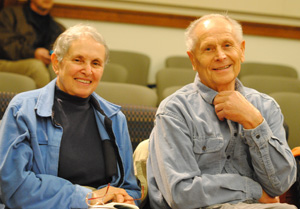
Judy and Manfred Schmidt were honored at the Nov. 16 park advisory commission for their volunteer work with the city's natural area preservation program. (Photo by the writer.)
Parks manager Colin Smith reported that the first four months of this fiscal year – from July 1 through Oct. 31 – are off to a good start. Year-to-date revenues of $918,091 represent an increase over the same period last year, when revenues were $793,783. Expenses for that period are down from $1.23 million last year to $1.07 million this year.
Commissioner Tim Berla asked for clarification about how much support parks is getting from the city’s general fund, and Smith said he’d prepare a report on that issue for PAC’s December meeting. General fund support for parks is important to track, Berla indicated, because it reflects a promise that city council made prior to passage of a parks millage in 2006: That the total general fund subsidy for parks wouldn’t be diminished as a percentage of the overall general fund. The issue also ties into which part of the city budget will be used to pay for dam maintenance.
During an update on the $1.168 million Argo Dam bypass project – which PAC had recommended at its Oct. 19 meeting, and which the city council approved on Monday – Berla said he’d like to have a discussion about how to get city funding for a skatepark as well. As a result of that request, PAC will likely have a work session in December or January that focuses more broadly on prioritizing capital projects, including a skatepark. Other potential projects mentioned by commissioner Gwen Nystuen include the Allen Creek Greenway, another dog park, and increased connectivity for the park system’s trails and pathways.
Commissioners also got an update about the two proposals submitted for Huron Hills Golf Course, and heard from parks planner Amy Kuras on the status of capital improvement projects for the parks. Kuras reported that West Park is now open to the public following an extensive renovation, and that a draft of the Parks & Recreation Open Space (PROS) plan will be distributed soon for public feedback, pending a city council vote authorizing that action.
At the start of Tuesday’s meeting, two long-time volunteers – Judy and Manfred Schmidt – were honored as volunteers of the year for the city’s natural area preservation program. The Schmidts were specifically commended for their decades-long advocacy and stewardship of the Scarlett-Mitchell Nature Area, a 25-acre park adjacent to Scarlett and Mitchell schools and Mitchell-Scarlett Woods. During his comments, Manfred Schmidt proposed a whimsical solution to the city’s budget struggles, a plan that involves the amount of buckthorn he’s cut down over the years. [Full Story]
Ann Arbor Council Passes Watery Agenda
Ann Arbor City Council meeting (Nov. 15, 2010): On Monday, the council postponed action on some major policy questions, but approved six water-related items.

Ann Arbor city councilmembers are ceremonially sworn in to start their two-year terms. From left to right: Mayor John Hieftje, Sandi Smith (Ward 1), Margie Teall, Carsten Hohnke (Ward 5), Tony Derezinski (Ward 2) and Christopher Taylor (Ward 3). Administering the oath, with her back to the camera, is city clerk Jackie Beaudry. (Photos by the writer.)
The council approved a $1,168,170 bypass around the Argo dam that will take the place of the current headrace, which is separated from the Huron River by an earthen embankment. The bypass will eliminate the portage currently required by canoeists. It would also allow the city to comply with the consent order it has with the state of Michigan that requires the city to address the repair of toe drains in the embankment.
Another item – on the funding of dam maintenance – was in its original form related more closely to the Argo bypass than in its amended version. The council approved a resolution that directed the city administrator to end the payment for repairs, maintenance and insurance of Argo and Geddes dams from the city’s drinking water fund. The shift in dam activity funding will be effective with the start of fiscal year 2012, which is July 1, 2011. An amendment to the original resolution, however, had the impact of leaving intact a previously budgeted $300,000 from the drinking water fund for possible construction of the Argo bypass.
The third water-themed agenda item approved by the council was $553,320 for fabrication of a piece of exterior art – a fountain-like sculpture – that had been commissioned from German artist Herbert Dreiseitl for the new municipal center. Dissenting votes were cast by Sabra Briere (Ward 1), Stephen Kunselman (Ward 3) and Marcia Higgins (Ward 4).
The council also approved the receipt of a $216,723 Federal Emergency Management Agency (FEMA) grant for the purchase and demolition the structures at 215 and 219 W. Kingsley Street, which are located in the Allen Creek floodway. The area is subject to flooding during heavy rainstorms. The site will be modified in a way to create a small stormwater retention area, with $72,241 in city funds for the project to be drawn from the stormwater capital budget.
The council approved a drainage easement related to the new underground parking structure being constructed on Fifth Avenue. A final item related to water – in its frozen form – was an authorization to treat the Big Chill hockey game on Dec. 11 the same way that football Saturdays are treated, with respect to vending and parking near Michigan Stadium.
Among the postponed items was a modification to the zoning code to regulate medical marijuana facilities. In conjunction with that postponement, the council also extended a moratorium on the use of facilities for dispensing or cultivating marijuana for 60 days – until Jan. 31, 2011. At the council’s Dec. 6 meeting, it will give initial consideration to a licensing requirement for medical marijuana facilities. Then at its Dec. 20 meeting, it will give final consideration to both the zoning regulations and the licensing proposal.
Also among the postponed items was the conversion of the city’s composting facility to a merchant operation, which would offer a contract to WeCare Organics, a New York-based firm. The proposal on the compost operation will come back to the council at its Dec. 6 meeting. The council also postponed for a third time revisions to the city’s area, height and placement zoning regulations. For another zoning-related item, the council extended a deadline from Dec. 6, 2010 to Feb. 22, 2011 for the design guidelines task force to complete its work.
In other action, the 15th District Court judges will now have a place to sit in the new municipal court facility. A previously twice-postponed item to authorize a budget revision of up to $160,000 to purchase furniture for the court was approved. The dollar amount was reduced to about half that figure, after the court was asked to produce an itemized list of the furniture it intended to buy.
The council also entertained a customary range of public commentary and communications from its own ranks. [Full Story]
PAC Recommends Argo Dam Bypass
Ann Arbor park advisory commission meeting (Oct. 19, 2010): Though the proposal facing park advisory commissioners wasn’t directly related to the question of whether to keep or remove Argo Dam, PAC heard from nearly a dozen people during public commentary who aired their views on that topic.
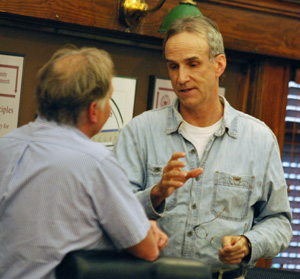
Dave Barrett, right, talks with fellow park advisory commissioner John Lawter prior to the start of PAC’s Oct. 19 meeting. Barrett represented PAC on a selection committee that recommended reconstruction of the Argo Dam headrace and embankment. (Photos by the writer.)
The resolution that PAC ultimately approved was a recommendation to build a bypass channel in the Argo Dam headrace for $988,170, and to add whitewater features for an additional $180,000. The $1,168,170 project would be designed by Gary Lacy of Boulder, Colo., and built by TSP Environmental, a Livonia firm.
City staff said this was the only proposal submitted that met the requirements laid out in the city’s request for proposals (RFP). The plan calls for removing the canoe portage, replacing it with a series of “drop pools” so that no portage is required. The project will also improve accessibility of the path – which is part of Washtenaw County’s Border-to-Border trail – and address problems in the headrace embankment that were identified by state officials. The work is tied to a consent agreement that the city reached with the state in May, laying out steps that the city must take to deal with some long-outstanding structural issues.
Commissioner Tim Berla voted against the resolution, calling it a “protest vote” because removal of Argo Dam hadn’t been considered as an option – that same point was made by several speakers during public commentary. Park staff has indicated that this project doesn’t preclude removing Argo Dam in the future, if that’s a decision that the community makes.
Funding for the project is available from the city’s Parks Rehabilitation & Development millage and the drinking water fund, according to city staff. An additional $50,000 might be available from the Washtenaw County Parks & Recreation Commission, to help pay for a portion of the project related to the county’s Border-to-Border trail.
Several people – both commissioners and speakers during public commentary – questioned the appropriateness of using the water fund for this purpose, saying that Argo dam has nothing to do with drinking water. Local attorney Scott Munzel argued that using the water fund to pay for dam-related projects might be illegal, based on case law, because it’s being used as a way to skirt the Headlee Amendment. Munzel is a board member of the Huron River Watershed Council, which has lobbied vigorously to remove the dam for environmental reasons.
The proposal for reconstruction of the headrace and embankment will now be forwarded to city council.
Also at Tuesday’s meeting, PAC members heard an update from parks staff about this season’s activities at the city’s three outdoor public pools – at Buhr, Fuller and Veterans Memorial parks. The former supervisor for Buhr Park Pool, Gayle LaVictoire, also gave a brief presentation to commissioners about her new job as volunteer outreach coordinator for the parks system, a newly created position.
And at the end of the meeting, Colin Smith, manager of parks and recreation, announced that the Ann Arbor Senior Center received more residents’ votes than other city facilities in a recent contest sponsored by Stonyfield Farm, and will receive $15,000 from that firm. [Full Story]
Seniors Host Ann Arbor Mayoral Forum
In his introductory remarks, Bill Kinley joked that this was the first mayoral debate – and possibly the last ever – held at University Commons, a condominium community for people over 55 that was founded by University of Michigan faculty. They’d have to see how it turned out, he said.

Bill Kinley moderated a mayoral debate at University Commons on Monday between incumbent John Hieftje and challenger Patricia Lesko.
Kinley, a University Commons resident and local developer, moderated Monday’s event, which drew about 50 people to listen as incumbent mayor John Hieftje and challenger Patricia Lesko answered questions for an hour on a range of topics, from Argo Dam and Fuller Road Station to the city budget and possible income tax.
It’s the latest in a series of exchanges between the two candidates, as the Democrats head into next week’s Aug. 3 primary election. [See Chronicle coverage: "Ann Arbor Forums: The More, The Mayor-ier" and "Ann Arbor Dems Primary: Mayoral Race."]
After introducing the candidates, Kinley cautioned that the residents there are “a group of wordy people.” They know that “platform” and “platitude” derive from the French word “plat,” he said, “so if you can keep platitudes to a minimum, you’ll find the reception here is much more responsive.”
Each candidate was given two minutes to answer the question. The first person who answered was also given the option of an additional one minute response. Questions had been developed by Kinley and the program committee for University Commons. [Full Story]
Two Dam Options for Argo
Ann Arbor Park Advisory Commission meeting (July 20, 2010): At their July meeting, park commissioners received updates on two projects that have drawn a fair amount of controversy: Argo Dam, and the Fuller Road Station.
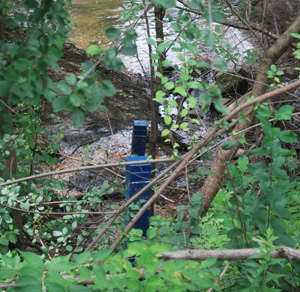
Looking down from the Argo Dam embankment, toward the Huron River. The blue metal casings hold piezometers to measure water pressures in the earthen berm. (Photos by the writer.)
First up was Argo, and city staff outlined details of a consent agreement signed with state regulators in May, which identifies steps the city must take to deal with safety issues at the dam. The city will be pursuing two options: getting bids to repair the toe drains on the dam’s earthen embankment; and issuing a request for proposals (RFP) for an entire embankment reconstruction. Ultimately, city council will choose between the options, based in part on a recommendation from PAC.
During public commentary, two speakers affiliated with the Huron River Watershed Council urged commissioners also to recommend getting a bid for an additional option – removal of the dam. And during a discussion after the staff presentation, commissioner Tim Berla called out the city council for not taking a vote on the dam-in/dam-out question. He said that by not voting, the council essentially made a back-door decision not to remove the dam. From an accountability standpoint, he said, a vote should be taken.
Commissioners were also updated on Fuller Road Station, a large parking structure and transit center – and possibly a train station eventually – proposed to be built on city land that’s designated as parkland. The joint project by the city and the University of Michigan was the subject of a resolution that PAC passed at its June 15 meeting, asking city council for more transparency in the process and to ensure the project results in a net revenue gain for the parks system. During the July 20 presentation at PAC, initial designs were presented and potential funding sources were discussed. Eli Cooper, the city’s transportation program manager, also told commissioners that Greyhound, which had initially expressed interest in the station, has now backed off – at this point, it doesn’t appear the bus company will use that site.
Later in the meeting, commissioner Dave Barrett gave an update on work that he and Berla are doing to assess the condition of the city’s ballfields. Some fields are in really bad shape, he reported. “It’s fair to say we have some work to do.” [Full Story]
City’s Budget Takes Backseat to DDA Issues
Ann Arbor City Council meeting (May 17, 2010): By its second meeting in May, the city of Ann Arbor’s charter stipulates that the city council must adopt a budget for the coming fiscal year, which starts on July 1.
On Monday night, the council unanimously adopted its roughly $78 million general fund budget – as amended to reflect new revenue items. Those new revenue items allowed the council to eliminate five firefighter positions and no police jobs. As originally proposed, the budget would have eliminated 35 fire and police positions combined.
Next year’s work will not be any easier. CFO Tom Crawford said at the meeting that he’s projecting a $5 million deficit in FY 2012.
Deliberations on the budget did not begin until late in the evening. Occupying more of the council’s time than the city’s FY 2011 budget were two issues related to the Ann Arbor Downtown Development Authority. One of those issues was a sidewalk occupancy ordinance applicable only within the DDA district. The ordinance, which legalizes the use of sandwich board signs, passed after a failed attempt by Marcia Higgins (Ward 4) to get it postponed.
The second DDA issue on the agenda involved a $2 million payment from the DDA to the city, which helped the council to amend its budget to reduce layoffs of fire and police. In approving the $2 million payment, the DDA board had included in its resolution a requirement to have a future public process for continued conversations between the city and the DDA about renegotiating a parking agreement between the two entities. From January through April of this year, conversations on that topic between the city and the DDA took place out of public view.
On Monday, the council considered a resolution thanking the DDA for the money and providing a commitment to public process for conversations about the parking agreement – parallel to the public process explicated in the DDA’s resolution. The council resolution passed – stripped of its language about open and transparent process on the grounds that it was redundant – after a brief attempt by Carsten Hohnke (Ward 5) to get the resolution tabled.
In other significant business, mayor John Hieftje nominated a replacement for Ted Annis on the Ann Arbor Transportation Authority board: Roger Kerson, who in 2008 contemplated a run for a Ward 5 council seat, but decided against it.
Anya Dale had been nominated by the mayor to replace Paul Ajegba on the AATA board at the council’s previous meeting. On Monday, confirmation of her appointment included one hitch – Sabra Briere (Ward 1) cast a vote against it. [Full Story]
Extra City Revenue Based on Optimism
Ann Arbor City Council Sunday caucus (May 16, 2010): On Monday night, the city council will deliberate on several amendments to the proposed city administrator’s budget that, if approved, would significantly alter the assumed revenue picture for that proposed budget. [Chronicle coverage: "Ann Arbor Budget Deliberations Preview"]
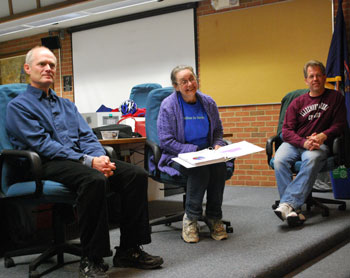
From left to right: mayor John Hieftje, Sabra Briere (Ward 1) and Stephen Kunselman (Ward 3). Briere looked up various facts in the FY 2011 budget book during the course of the caucus. (Photo by the writer.)
The city council’s regular Sunday night caucus, which again enjoyed only sparse attendance – from four out of eleven councilmembers – gave a glimpse into how part of the city council is thinking of the possible changes in revenue items. One of those changes to revenue items is certain – the DDA agreed at its May 3 meeting to pay the city $2 million to help cover general expenses at the city.
Two other revenue changes are based on projections, not payments – an additional $625,000 in parking fine revenues, plus almost $1 million in statutory state shared revenues. The additional state shared revenue is an amount that the city administrator assumed for his budget would not be forthcoming from the state.
During the Sunday caucus, mayor John Hieftje attributed the difference in outlook on state shared revenues to a difference in political perspective. He said that Roger Fraser, the city administrator, is “not as plugged in” to the political considerations in Lansing as he and the rest of the city council are.
Questions were raised among residents about the certainty of the extra $625,000 in parking fine revenues. Those questions were raised in the context of the DDA’s interest – as expressed in the term sheet produced recently by a “working group” of city councilmembers and DDA board members – in moving towards a parking enforcement system managed by the DDA and designed to reduce the number of parking tickets.
The revenue items are key to budget amendments that would result in eliminating five firefighter positions – instead of the 20 firefighters and 15 police officers that the city administrator’s budget calls for.
At the caucus, Stephen Kunselman (Ward 3) gave some insight into an amendment he’ll be bringing forward to reduce the tax administration fee from 1% to .81%. When the fee was increased from .81% to 1% in 2007 for the FY 2008 budget, explained Kunselman, it had not come as a request in the administrator’s budget. The increase, he concluded, had not been made in order cover costs of administering the property tax – they were already covered.
Councilmembers at caucus had no information on the possibility of moving maintenance costs for Argo Dam out of the city’s water fund. Indications from city official on multiple occasions through the fall of 2009 and winter of 2010 were that those maintenance costs would be moved from the water fund to the parks fund. [Full Story]
Pleas for Human, Safety Services at Council
Ann Arbor City Council meeting (May 3, 2010): Several speakers addressed the city council at its Monday meeting asking for continued funding for human services and to avoid layoffs in the city’s police and fire departments.

Firefighters held an informational demonstration Monday afternoon before the city council's meeting at Station 1, which is located across the street from city hall. Firefighters from Flint, Dearborn, Dearborn Heights, Ann Arbor Township, Ypsilanti, Battle Creek and Ann Arbor took part in the demonstration. (Photos by the writer.)
And Margie Teall (Ward 4), who faces two challengers in the August Democratic primary, announced a planned amendment to the city’s proposed budget that would maintain human services funding at FY 2010 levels. The amendment, which will be brought forward at the council’s May 17 meeting, would also avert as many layoffs in the police and fire departments as possible, she said.
The previous evening at the council’s Sunday night caucus, Mike Anglin (Ward 5) and Sabra Briere (Ward 1) had already indicated they would support using part of a possible $2 million payment from the Downtown Development Authority to avoid police and firefighter layoffs.
The council’s plan for funding the amendment, reported Teall, is to use a $2 million payment from the Downtown Development Authority that it hopes the DDA board will approve at its May 5 board meeting. Even if the DDA board approves the payment, which is very likely but not certain, not all safety services layoffs in the city administrator’s proposed budget could be covered. Averting the elimination of 35 positions across police and fire departments combined would require $3.6 million. The restoration of human services funding would require another $260,000. And that would still result in the city tapping its general fund reserves for $1.5 million.
In its business for the evening, the council passed a resolution added late Monday to the council agenda, which strikes an agreement between the city and the Michigan Dept. of Natural Resources and Environment for the future of the embankment along Argo Dam. It will allow the headrace to be re-opened by the end of this week.
The council also approved on first reading a revision to the city’s sidewalk occupancy permit system to include sandwich board signs. And the residential development now called Heritage Row – proposed along Fifth Avenue south of William Street – was approved at the council’s first reading with no discussion, but with dissent from Mike Anglin. Both of those measures will need to come back before the council for a second reading to gain approval.
The council also approved received the mayor’s nomination of the appointment of Anya Dale to the AATA board, replacing Paul Ajegba, whose term expired on May 1. Ajegba had been elected by his colleagues last fall to chair the board. Dale is a Washtenaw County planner. Her appointment will be presented for confirmation at the council’s May 17, 2010 meeting.
The council also approved some additional road closures for the June 6 Dexter-Ann Arbor Run. [Full Story]
More to Meeting than Downtown Planning
Ann Arbor City Council Meeting (Nov. 16, 2009) Part II: The length of Monday’s city council meeting, which did not adjourn until nearly 1 a.m., might be blamed on the lengthy public commentary and deliberations on downtown zoning and design guidelines.

Left to right: Stephen Kunselman (Ward 3), Sabra Briere (Ward 1) and Stephen Rapundalo (Ward 2) getting ceremonially sworn in at the start of council's Nov. 16, 2009 meeting. Standing to the left out of frame are Marcia Higgins (Ward 4) and Mike Anglin (Ward 5). (Photo by the writer.)
But it would have been a long meeting even without the downtown planning content, which we’ve summarized in a separate report: “Downtown Planning Process Forges Ahead.”
Before postponing the acceptance of the Huron River and Impoundment Management Plan (HRIMP), the council got a detailed update on how things stand on the city’s dispute with the Michigan Department of Environmental Quality (MDEQ) over Argo Dam.
An agenda item authorizing capital improvements in West Park prompted a lengthy discussion of how the Percent for Art program works.
Some public commentary calling abstractly for greater support for inventors and entrepreneurs was followed later in the meeting by an appropriation from the city’s LDFA to Ann Arbor SPARK to fund more business acceleration services.
A consent agenda item on the purchase of parking meters was pulled out and postponed.
The council also heard a detailed report from the city administrator, which covered emergency response time to a recent house fire, ADA-compliant sidewalk ramps, responses to the library lot Request for Proposals, updates on the task forces for Mack Pool and Ann Arbor’s senior center, staff reductions in planning and development, the East Stadium bridges, as well as the upcoming budget retreat on Dec. 5.
Stephen Kunselman’s (Ward 3) use of attachments to the agenda to document questions for city staff received some critique.
Also worth noting, the five winners of recent council elections were sworn in, and Marcia Higgins (Ward 4) was elected as mayor pro tem. Those topics in more detail below. [Full Story]
Council OKs Recycling, Transit, Shelter

Left to right: Brian Nord and Caleb Poirier (back to camera), who are both advocates for Camp Take Notice, a self-governed encampment of homeless people. Also Sabra Briere (Ward 1) and Mayor John Hieftje. (Photo by the writer.)
Ann Arbor City Council meeting (Nov. 5, 2009): Meeting on Thursday due to the elections, instead of in its usual Monday slot, Ann Arbor’s city council moved ahead on two major initiatives that will eventually have a significant impact on Ann Arbor residents.
The council approved a memorandum of understanding with the University of Michigan to move forward on joint development of the Fuller Road Station, which offers the university an alternative to construction of a parking deck on Wall Street. The first phase of the project is anticipated to be completed in mid-June 2012.
Also given a green light was a conversion to single-stream recycling – a single cart will be distributed to residents to replace the twin totes currently used for curbside pickup. The new carts will be rolled out in June 2010.
A more immediate impact will be made by a council decision to allocate a combined $159,500 to the Shelter Association of Washtenaw County and the Interfaith Hospitality Network – the funds will increase the sheltering capacity by 50 spots for individuals through the winter, starting Dec. 1, and provide housing vouchers for eight families for a year. [Full Story]
City, MDEQ Agree: Argo Headrace Shut

Argo Dam headrace closure. Without the metal plate, water would flow from left to right (bottom to top) in the photograph. The greenish metal plate is wedged into the concrete slot in shim-like fashion. The slot continues along to the bottom of the channel. (Photo by the writer).
The city of Ann Arbor and the Michigan Department of Environmental Quality have moved towards resolving a dispute about what needs to be done to address problems with the earthen embankment next to Argo Dam. Late this summer, the MDEQ had issued an order to the city to close off the flow to the headrace and dewater it by Nov. 1. That order was based on concerns about the structural integrity of the earthen berm dating back several years.
The city had retained the law firm Bodman, LLP on the matter, and filed a contested case with the MDEQ, asking for a 90-day stay on the MDEQ’s order, which includes a stoppage of flow in the headrace, and its dewatering.
The order also includes other points, among them a need for the city to make a decision on the dam-in/dam-out question. Whether to keep Argo Dam in place or remove it has been the focus of community-wide conversation on that topic, which has taken place with great intensity over the last nine months, but which has a years-long history.
The MDEQ agreed to the city’s request for a stay on all elements of its order except for shutting the water flow to the headrace. The city has now complied with the MDEQ’s order to close the headrace. [Full Story]
Still No Dam Decision
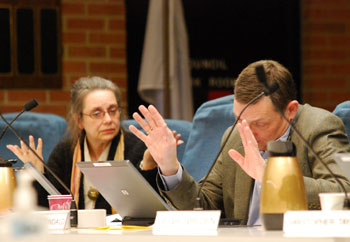
Leigh Greden, who chaired the meeting as fourth in the line of mayoral succession, did not at any point abuse the temporary power by saying, "Everybody show me your hands!" Sabra Briere (Ward 1) and Stephen Rapundalo (Ward 2) are in fact sussing out which version of the Argo Dam resolution the city clerk had circulated. (Photo by the writer.)
Ann Arbor City Council meeting (Oct. 19, 2009): A city council whose ranks were reduced by four members – due to family medical issues and personal illness – tabled a resolution on Argo Dam that would have expressed the body’s intent to keep Argo Dam in place and to perform necessary repairs mandated by the Michigan Department of Environmental Quality.
The tabling came only after long deliberations, which included a recess, and focused mainly on the question of tabling versus postponing until a date certain.
Several people spoke during reserved public commentary time on the issue of Argo Dam. But the dam question was somewhat overshadowed for some in the audience by a presentation on homelessness at the beginning of the meeting from Mary Jo Callan, who’s director of the combined county-city office of community development. Said one speaker during public commentary: “After hearing the stats on homelessness, I’m ashamed to be standing here talking to you about Argo Dam.”
The presentation on sheltering the homeless – especially during the winter – included a specific call to action from Ellen Schulmeister, director of the Shelter Association of Washtenaw County. She asked community members to start conversations at their churches, synagogues, mosques or other community groups about how they might be able to provide volunteer support and space to expand the current rotating shelter program. Schulmeister asked that the conversations begin now, “So that when we ask, you’re ready to go.”
In other major business, the city council authorized the expenditure of $100,000 for removal of five failing beams on the East Stadium bridge over State Street – beams which run under a portion of the bridge currently closed to traffic. The work is scheduled for Sunday, Nov. 15 through Tuesday, Nov. 17 and will require the closing of State Street during the work.
The council also approved the next step in the creation of a Business Improvement Zone (BIZ) along Main Street between William and Huron streets. [Full Story]
Finally a Dam Decision on Argo?
Ann Arbor City Council Sunday night caucus (Oct. 18, 2009): At its Sunday night caucus, Ann Arbor city council members heard from only a couple of residents who actually spoke in favor of keeping Argo Dam in place.
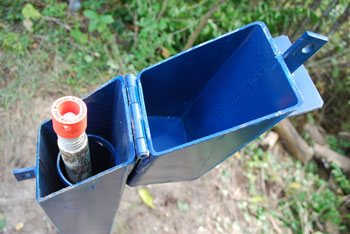
Piezometer installed in mid-September along the earthen berm separating the Argo Dam headrace from the river. (Photo by the writer)
But those speakers were supported by the presence of almost two dozen others who attended the regular Sunday evening affair, to make clear that they also supported a resolution on the dam – which was added to Monday’s Oct. 19 agenda on Friday, Oct. 16.
Monday’s resolution, which is sponsored by Stephen Rapundalo (Ward 2), Marcia Higgins (Ward 4), and Sandi Smith (Ward 1), expresses the intent of city council to keep the dam in place. [Text of the resolution]
At caucus, one of the voices of dissent on the resolution belonged to Laura Rubin, executive director of the Huron River Watershed Council. She told the three councilmembers present – Stephen Rapundalo (Ward 2), Sabra Briere (Ward 1), and Mike Anglin (Ward 5) – that there’d been an expectation that the city council would follow the example of the city’s Park Advisory Commission and the Environmental Commission by holding a formal public hearing on the vote.
The resolution on Monday’s agenda does not include a public hearing.
After the caucus concluded, Rubin told The Chronicle that the expectation of a city council public hearing was based on a hearing that had been planned for July 6, 2009, but that was canceled when the council decided to ask the Michigan Department of Environmental Quality for more time to decide. We had a look at The Chronicle archives to verify that contention.
Other caucus topics addressed by residents included a crosswalk to be installed at the intersection of Waldenwood and Penberton drives and a request for an update on the East Stadium bridges. Council will consider a resolution on Monday to follow the advice of an outside engineering consultant to proceed with removal of bridge beams supporting the southern lanes, which are currently closed to traffic. [Full Story]




